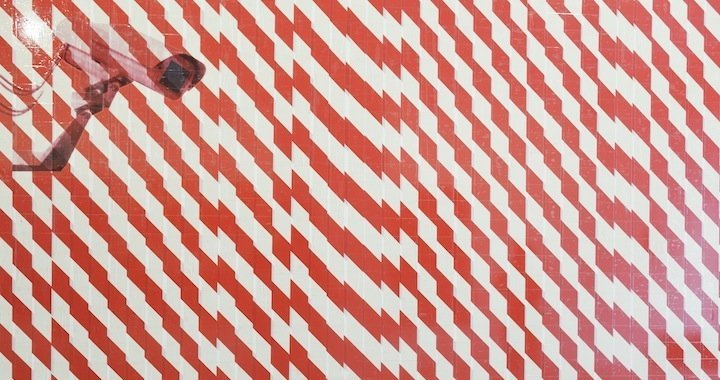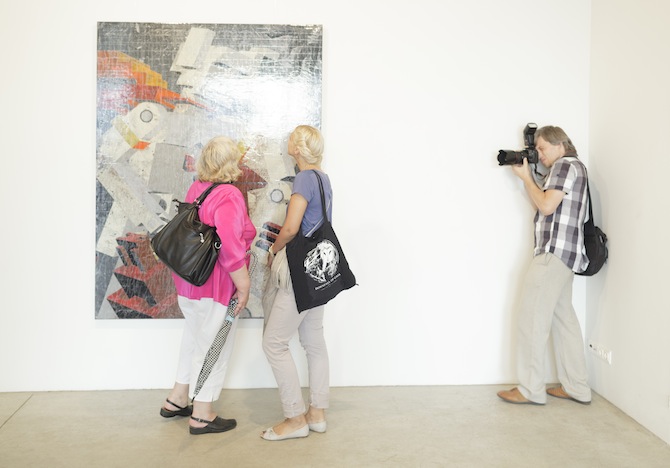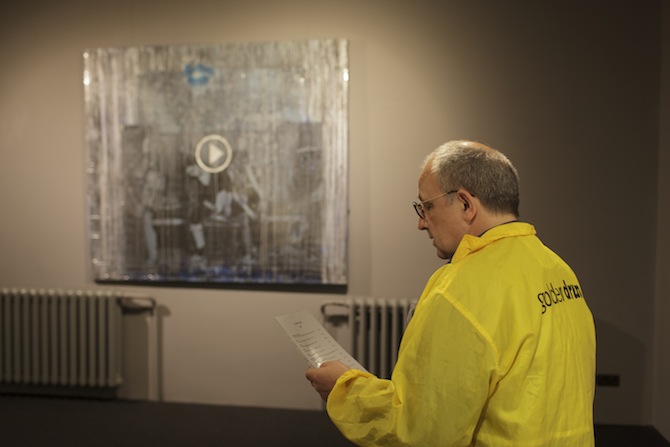
Ģelzis in Minecraft: Some Bits and Pieces
Pēteris Bankovskis
05/08/2013
Photo: Andrejs Strokins
Kristaps Ģelzis' exhibition, “2013”, can be seen in gallery “Māksla XO” (Riga, Latvia) through 13 August
It's weird: an artist, for example, Latvian artist Kristaps Ģelzis (1962), surrenders to some sort of influences and the feelings and thoughts that they suggest, and then – submits to a rational comprehension of actions of one kind or another, which are followed by acts of volition, and as a result – a piece of work is created in a period of time. Let's put it this way: in a year's time, as a result of a tangled ball made up of all previous experiences, probabilities, coincidences, physical materials and purpose-led activities, works have been created “for exhibition”.
Various agreed-upon assumptions and socio-economic conditions dictate that these works be arranged in a space – let's say, the gallery “Māksla XO” – where for about a month, they can be seen by both casual passersby and those who go to the gallery because going there is, in a certain way, an integrated part of their plans for a fulfilled life. During this short visit, hoped-for preconceived notions are met, and the visible message sent by the artist's displayed “exhibition pieces” transform into “impressions” – which is nothing more than the coming together of the hoped-for and the found into a new homunculus. After a while, with this homunculus tucked under his arm, the visitor goes on his way. Soon after, a visitor like this blends together this clump of impressions with his general, and constantly changing, “inner world”, and that is enough. Because of an agreement, someone attempts to clothe the exhibition into words – he writes it down and publishes it somewhere, like on this website. On the day when this grouping of words becomes available to its potential readership, the words seem to come to life for a moment – more or less, and either poorly or well, they resonate a wordy, conceptual or emotional thought process in the people who are reading them. There aren't many people like this; perhaps some of them have already been to the gallery and have seen what it is that is being written about, and there – on site – they have already had their first thoughts “on the subject”. Now – whilst reading the text, these thoughts already have been, of course, deformed by time, and have tangled with the new thoughts suggested by the text. Afterwards, everything settles down. The quantitative aggression found in textual and other forms is so merciless in the space of the present that its elements, one following the other, constantly swallow their predecessors. This is especially visible in the realm of the internet, where a piece of news lives for a couple of hours – alright, sometimes for a day – but then it is swallowed by the next piece of news.

Today, Kristaps Ģelzis' latest exhibition at the gallery “Māksla XO” gives impetus for thinking, or at least for some curiosity; tomorrow, it will already be “stored in the archive” – like everything in this present-day disposable civilization, which is most reminiscent of a garbage dump.
Ģelzis is not the only one who, being an artistic soul – and therefore, one who feels the spirit of the times – wishes to, and knows how to, clothe in a material image his relationship with the existent, of which he himself is a part. Some would like to call him a conceptualist; I'm more apt to see in him a link to the grouping of views that Michael Paraskos, a Cyprian-born Brit, has deemed “The New Aesthetics” (not to be confused with James Bridle's “The New Aesthetic”, in singular form). To summarize in a sentence, Parskos' “New Aesthetics” means a realistic (interpret this as you will) act of art that overcomes conceptualism, and stresses and pronounces its materiality. For example, in his adulatory newspaper article on Van Dyke's exhibition, Paraskos accents the visible and traceable strokes of layered paint. Namely, the object that has formed as a result of the artist's efforts is what is important, not the thicket of hopes, concepts and behind-the-scenes struggles.
Connected links:
A photo-report of the opening of Kristaps Ģelzis' exhibition, “2013”
A video “Sneak Peek” of Kristaps Ģelzis' workspace
In exhibitions of Kristaps Ģelzis' works, the object is always important. In addition, and this should be stressed, these are not ready-made objects, whether they be manufacturing scraps, or prepared clichés from painting or some other artistic technology. The New Aesthetic denies the mechanical pseudo-cleverness of the ready-made; it reaches towards recreating a collection of unavoidably repetitive empirical experiences. For some time now, Ģelzis has tried delivering his message about our times through the use of elements from our garbage-society: plastic sheeting, duct tape, as well as the accidental picturesqueness of the city. If he were a conceptualist, Ģelzis would be satisfied with making a messy pile of garbage in the corner of an exhibition space, or with the transferring of a pointless stencil or piece of graffiti to the gallery. Doubtless, these thoughts have never crossed his mind. Ģelzis uses contemporary (in the sense that they completely surround us) objects and concepts only as raw material. He makes paintings in the most regular sense of the word: spatially limited, transferable messages displayed on a flat plane. He tells of his relationship with being Latvian (yes, yes!); about the sadness that takes over when he realizes that life is slowly passing by, and that the “exhibition pieces” of his past are ghosts of the past. But in Ģelzis' case the story is not sweetly nostalgic, but rather merciless and sarcastic – in the same way that the artist himself has, occasionally, outwardly projected himself to be. In painting his sadness at what has passed, as well as what is ambivalently valued, even just the scrupulous use of rubbish-materials makes “lovers of art” understand that the present is like a plastic bag blown by the gusts of a dirty city street, and that the future is veiled in a fog of uncertainty. Because who can tell how long a life these paintings, made of layers of plastic sheeting, will last? For how many years will they look like works of art as they sit in a collection, or in an attic?

The artist is sarcastic in another sense as well – besides the multi-layered visual imagery and the “timeless” intentions of his paintings, he's also layered on an element much like a computer-screen arrow that the viewer's imagination can click on to play, or to stop. Namely, Kristaps Ģelzis is smart enough to tell the viewers of his works that they have the choice to either “play” what he has to offer, or to press “stop” – and go busy themselves with Minecraft or something else just as banal. Oh, yeah – and he still has a Latvian passport in his pocket.
Elizabetes iela 14
Riga, Latvia
www.makslaxogalerija.lv